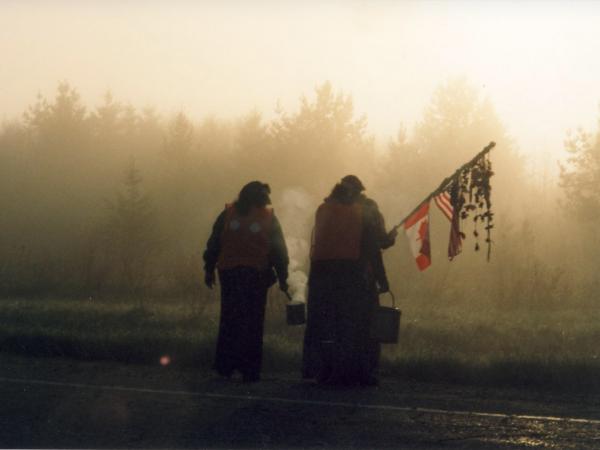Since 1993 with a declaration by the United Nations, World Water Day has been marked internationally on March 22 each year to acknowledge the many water crises around the world. Across Turtle Island, it portends the annual Mother Earth Water Walk that was founded by Ojibwe conservationist Josephine Mandamin.
The U.N.’s Sustainable Development Goals set in 2015 call for access to safe water for everyone by 2030. Today, the annual theme focuses on wastewater, calling attention to the at least 1.8 billion people in the world whose drinking water is contaminated with fecal matter.
But meanwhile, in the water-wealthy United States and Canada, that life-giving resource seems under threat—from controversial oil pipeline and mining projects that potentially endanger drinking water sources, to proposed cutbacks in federal and state regulations intended to protect water and land.
This year, once again, some Native grandmothers will take the lead in calling attention to the needs and gifts of the waters that flow around our lands and through our lives. A spring walk will travel west to east across the United States and Canada along the Great Lakes waterways, and a late summer journey will follow the length of the Missouri River, considered by many to be imperiled by the Dakota Access Pipeline (DAPL) being dug beneath it.
Starting out on April 19 from Spirit Mountain in Duluth, Minnesota, near the farthest western point of the great Lake Superior, Mandamin,Wikwemikong First Nation, will lead this year’s Mother Earth Water Walk, “For the Earth and Water Walk 2017: From West to East.” She and others plan to walk nearly 1,500 miles to Matane, Quebec, on the eastern part of the St. Lawrence Seaway. A corresponding canoe journey, Picking Up the Bundles, plans to paddle alongside the Nibi (Water) Walkers.

Via Facebook
Participants in the annual Mother Earth Water Walk wend their way around a different Great Lake each year and up the St. Lawrence River Seaway. The Anishinaabe walkers embrace the theme of the walks, which started in 2003: “Ni guh Izhi chigay Nibi onji.” (“I will do it for the water.”)
The route will revisit major stopping points along the Ojibwe people’s prophesied and fulfilled migration from the east to the homelands of the Lake Superior region. As with her first Water Walk around Lake Superior in 2003, Mandamin intends for the walks to show solidarity with the water, to meet and educate people along their path, and to call attention to all that endangers clean, healthy water.
“In walking around the five Great Lakes, we learned something about each of the lakes,” Mandamin said in a 2008 interview after a multi-year series of Water Walks circled those lakes.
“We found the majesty of the lake, it is so powerful, so clean and so pure,” she added, referring to Lake Superior, the shores by her home. “You want it to stay like that forever and ever and ever, for the generations to come.”
Mandamin, though she has always lived by the Great Lakes, remembers a time when she, like those 1.8 billion people cited by the United Nations, did not have easy access to clean water.
“I remember when I was five or six years old, we were always out of water, and the wells were dry, and that was in the forties,” she said not long after that first walk. Earlier this month not far from Thunder Bay, the small town of Schreiber on Lake Superior had several days of a boil-water advisory because of bacteria found in the drinking water.
To raise funds to cover the West to East walk, artists continue to donate items such as star quilts, birchbark medallions and special fine art prints and photography for a current Facebook auction that ends at 7 p.m. EST on April 7.
Toward the end of summer, in August, another walk headed by Sharon Day, who took over the Water Walks when Mandamin ended her annual treks, will follow along the Missouri River for another Nibi Walk (Ojibwe for Water Walk).
As with the spring Water Walk, those who join along the 2,341 miles of the Missouri River will carry water from the river’s source and pray along its pathway. They also will interact with residents as the walkers travel and do interviews and presentations calling for protection of the water.
“There are so many people who told us their stories, there are just so many stories,” Day said after walking the length of the Mississippi in 2013. “We listened to all of their stories, their fears. It’s just incredible.”
As they walk, they listen to the water too, Mandamin said.
“It is human, it can sense, it can feel, it can hear what you’re saying.”
On this World Water Day, it would be good to say “thank you” to the water.
© 2017 Indian Country Today Media Network, all rights reserved. https://indiancountrymedianetwork.com
https://indiancountrymedianetwork.com/news/environment/world-water-day-ojibwe-water-walk/
